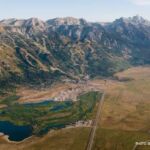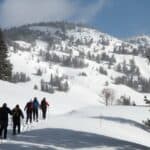Read The
Current Issue
Finding the Right Balance
What’s maybe more difficult than managing an expanse of wildland the size of Connecticut? Guiding and planning its future.
// by molly absolon

How do you plan for the future of the Bridger-Teton National Forest, which is roughly the size of the state of Connecticut? How do you balance the health of the wildlife that lives within that forest’s boundaries with the growing demand for outdoor recreation? How do you incorporate the values and interests of adjacent communities while also considering those of the people across the country and around the world who treasure the place? How do you plan for multiple-use and sustained yield when such uses inevitably conflict and conditions change?
According to the people charged with the task of revising the Bridger-Teton National Forest’s forest plan, the answer to all of the questions above is: “carefully.” Although originally envisioned to guide policy for roughly 15–20 years, the BTNF’s current forest plan has been in place since 1990. And conditions on the ground have changed dramatically in the 35 years since. In 2024, the BTNF embarked on a multiyear revision process to update that document. They hope to have a new plan by 2028, though that date is a goal, not a firm deadline.
“The National Forest Management Act of 1976 said all national forests have to produce overarching, integrated management plans to guide policy,” says Linda Merigliano, the Bridger-Teton’s engagement and recreation specialist. “This is a comprehensive strategic document. It lays out vision and overall goals, and is the document that guides all project decisions. It’s a little obtuse for the public. The plan is not making specific decisions. It’s more like a county comprehensive plan—like a zoning document—that identifies the right uses for the right locations.”
The Bridger-Teton National Forest is often described in superlatives. As the single-largest mass of public land within the 15-million-acre Greater Yellowstone Ecosystem—one of the largest nearly intact ecosystems in the northern temperate zone—the forest is home to some of North America’s most iconic wildlife species. It’s also the headwaters of three major watersheds (the Missouri, Snake, and Green Rivers) and a mecca for recreation ranging from mountain biking to skiing, dirt biking, fishing, snowmobiling, birdwatching, hunting, hiking, camping, and boating, among countless other outdoor pursuits.

The BTNF is the single-largest mass of of public land in the Greater Yellowstone Ecosystem and is home to iconic wildlife species.
The BTNF is home to 355 species of birds, 74 species of mammals, 35 species of fish, six species of amphibians, and six species of reptiles.
Less important to the BTNF are minerals and oil and gas. It’s just the luck of geology that has kept these industries from having a hold on the local economy, although grazing, and, to a lesser degree, small-scale timber harvesting are important uses of the forest and will also need to be considered in the forest plan revision.
Kathy Rinaldi, the associate director of conservation for the Greater Yellowstone Coalition, points to intact, contiguous habitat as one of the most precious things about the BTNF, and one her organization has prioritized protecting. “Think of the Wasatch Range [near Salt Lake City]. Think of the Front Range in Colorado. Those forests are broken up by roads, communities, and inholdings of private land. There’s a reason the longest remaining ungulate migration in the Lower 48 goes through the Bridger-Teton. We have intact habitat, and we’re not going to get that back if we lose it.”
But wildlife and habitat are just two of the things Merigliano and her team have to weigh. National forest management is dictated by the 1960 Multiple-Use Sustained Yield Act, which states, “It is the policy of the Congress that the national forests are established and shall be administered for outdoor recreation, range, timber, watershed, and wildlife and fish purposes.”
“We have lots of debates trying to find the right balance for all these different mandates,” Merigliano says. “I think there are some misperceptions out there about what ‘multiple-use sustained yield’ means. Some people take it as a code for extractive, commodity production, when it really means we have to blend all these activities.”

During the first stage of the planning process in 2024, the BTNF worked to lay the groundwork for the actual forest plan revision. This initial stage involved gathering data and the best available science to determine current ecological, social, and economic conditions and trends affecting the BTNF, as well as beginning the public engagement process. A 500-page assessment document consolidating all this information was scheduled for release in the fall of 2024 but is not coming out until this summer, indicating how complex and time-consuming the revision process can be. Many forests and other public land agencies take 10 years or more to complete management plans.
The BTNF has now moved into drafting the new forest plan using the information gathered last year. When completed, that plan will go through the standard National Environmental Policy Act process, which includes opportunities for public comment. Merigliano says that overall, they were pleasantly surprised by what they heard from the people who weighed in during the early stages of the planning process. “The values expressed are pretty stable,” she says. “We kept hearing the same thing over and over again. People agree on the importance of wildlife.”
According to the 2024 report Study of Preferences and Values on the Bridger-Teton National Forest compiled by Jessica Western of Big Goose Resolutions (and funded by the state of Wyoming, the Governor’s Office, and Fremont, Lincoln, Sublette, and Teton Counties) other key values identified by the public include recreation, biological diversity, protecting the resources for future generations, and aesthetics (scenery, sights, sounds, smells, etc.).
There are some subtle differences in values depending on location, however. Teton County residents identified conservation (protecting wildlife and fish habitat, wilderness, watersheds, and Wild and Scenic rivers) as the highest priority, while Lincoln, Sublette, and Park County respondents ranked recreation most highly.
“It’s easy to get tunnel vision in Jackson Hole,” says Teddy Collins, Wyoming conservation associate at the Greater Yellowstone Coalition. “But the forest extends almost to the Utah border, and the communities adjacent to it are as different as the landscape. You have Jackson, and you have Cokeville. There are millions of acres people in the Tetons have never set foot in. This plan is not about your favorite trail. It’s about 3.4 million acres. Six ranger districts. People feel like the part of the forest they love is theirs, but it’s a lot more complicated.”
For the forest planners, the history of conservation in the Greater Yellowstone Ecosystem is a plus. The debates that raged in the West in the 1980s over extraction versus protection are less pronounced around the BTNF, in part because those industries have never been big economic drivers here but also because the area has long recognized the economic, aesthetic, biological, and spiritual importance of the natural environment. Sharing a conservation ethic is a good starting place for coming up with a plan that everyone can live with. However, when it gets down to specifics, special interests will undoubtedly still provoke conflict.

Climate change is already on the Bridger-Teton’s radar, particularly with regard to wildfire.
There are six mountain ranges in the BTNF: the Tetons, the Gros Ventres, the Wind Rivers, the Wyoming Range, the Salt River Range, and the Snake River Range.
“The history and economies of the communities surrounding the BT are different,” says Merigliano. “Sublette County has a history of ranching. Ranching conserves range land, which is not totally incompatible with wildlife. Lincoln County is long and skinny. Alpine is a pretty different beast from Kemmerer, which was tied to coal. The Afton area’s historical economics were largely dependent on dairy and cows. It had all these cheese factories, and there was a timber mill there. Furthermore, recreation in Sublette and Lincoln Counties tends to be more motorized. All these things give the communities different perspectives on how the forest should be managed.”
“We are trying to make [the forest planning process] as much of a grassroots effort as possible,” Merigliano says. “We’re going to listen to the public, listen to the state, listen to cooperating agencies and the Tribes, and really focus on where we find commonality, not where we see differences.”
And yet, while a mountain biker may have the same overarching values and love for the outdoors as a horseback rider, dirt biker, or hiker, their differences can be glaring when it comes to just how forest use is appropriated. In 2018, Teton County (Wyoming) formed a committee of special interest groups to try to come up with a consensus recommendation for the futures of the Palisades and Shoal Creek Wilderness Study Areas, the former of which is in both the BTNF and the Targhee National Forest and the latter of which is entirely within the BTNF. That process broke down when members refused to make concessions on key issues. The future of those wilderness study areas remains in limbo, though the new forest plan may provide some direction.
“I think we’re going to see two plans within the overall plan,” says Teton County (Wyoming) Commissioner Luther Propst. “One for Teton County and one for the other counties. Teton County is kind of like a county in Colorado. Lincoln and Sublette have more of an old-school dynamic.” Propst worries that all the planning effort could be stymied by a lack of funding. He points to the challenges the BTNF faced in the fall of 2024 finding enough money to fully staff the Bridger-Teton Avalanche Center, which provides daily avalanche forecasts to thousands of winter recreationists. Propst said Wyoming Senator John Barrasso (R) played a key role in finally securing the dollars needed to pay for critical staff, but the experience does not bode well for the future of forest funding. “You can create a huge, lovely plan, but the question is whether Congress is going to fund it,” he says. “Unfortunately, with the federal budgeting process, we have to fight for every dollar.”
Despite all the potential challenges, a new forest plan is desperately needed. In the 35 years that have passed since the first—and only—forest plan was put in place, much has changed, and the current plan—despite being amended 13 times—fails to address many things that are now of prime importance to the BTNF and the people who live near its borders.
“I see two main challenges that weren’t highlighted in the last plan,” says Taylor Phillips, the founder of EcoTour Adventures and one of the creators of WYldlife for Tomorrow, an initiative that inspires businesses and individuals who depend on Wyoming’s wildlife to help fund on-the-ground conservation efforts. “The most pertinent are recreational pressures and climate change,” he says. “Recreational pressure is intense now. More people are visiting the ecosystem, more people want to get out and about to recreate, and better equipment is allowing folks from around the world to access wild places here. There’s incredible value in providing opportunities to bird, hike, mountain bike, and backcountry ski, and for motorized experiences as well. The tricky piece is to provide opportunities that do not favor one value over the other, while still protecting the resource. At the end of the day, with advancing technology and the increasing number of users, all user groups will have to make sacrifices.”
“And climate change is so incredibly difficult,” Phillips says. “I think that the forest service, really all public land managers, need to take a deep dive and look into the future to try to see what things could look like in 20, 30, even 50 years. That really needs to frame how they manage things like recreation and the extraction of timber.”
Climate change is already on the Bridger-Teton’s radar, particularly with regard to wildfire.“There was no discussion of climate change in the last plan,” says Matt Gaffney, who served as the interim forest planner for the BTNF last winter. “Fire is going to be a big deal, especially with all the beetle kill and dead and down fuel on the forest. And obviously water is a huge issue. Water was certainly discussed in the 1990 plan, but it is so critical it will definitely be a much bigger topic this go-round.”
The Greater Yellowstone’s Rinaldi hopes for a plan that is able to adapt to contemporary challenges, human development, and a warmer, drier climate. “The Bridger-Teton represents a host of GYC’s organizational priorities, most importantly interconnected habitat and water. Our ecosystem is going to be a climate refuge for cold-water trout, to say nothing of other wildlife species. We hope for a plan that at least maintains, if not enhances, protections.”
Public Involvement
The BTNF is engaging the public in a variety of ways as it revises its forest plan.

First, there are the cooperating agencies, as defined by the National Environmental Policy Act. For the BTNF’s forest plan revision, the group of cooperating agencies includes 10 Wyoming state departments, ranging from geology, parks, forestry, agriculture, and game and fish to the Department of Environmental Quality and the historic preservation office. The counties of Fremont, Lincoln, Sublette, and Teton are also cooperating agencies, as are local conservation districts and the Governor’s Office. The goal of identifying and working with these organizations is to tap into specific areas of expertise, as well as to integrate different social and economic concerns into the forest plan.
Tribes that have ancestral links to the BTNF have a special status as sovereign nations in the forest planning process. Several Tribes have expressed interest in being involved. These include the Shoshone-Bannock, the Comanche, the Crow, the Kiowa, the Northern Arapaho, and the Eastern Shoshone. Their specific concerns include ensuring the forest plan respects treaty rights as well as protects areas and species of special cultural significance.
Local voices—citizens and nongovernmental organizations—from the communities surrounding the BTNF—specifically western Wyoming, eastern Idaho, and northern Utah—have been identified as key partners by the forest in its planning process. In addition, “distant voices”—citizens from across the nation or world—will have opportunities to express their opinions by submitting comments. In general, the more specific these comments are, the more weight they carry.
Citizens can access information on the forest planning process at the Bridger-Teton National Forest Land Management Plan Revision Hub: fs.usda.gov/detail/btnf/landmanagement/planning/?cid=FSEPRD1177489. The hub provides information on the planning process, the timeline, and ways to be involved.
Forest Plan Revision Process and Timeline
2023: Gathering Data and Best Available Science was mostly done in 2023, although the forest will continue to incorporate relevant data and science in response to input from cooperators and the public throughout the planning process.
2023-2024: Public Engagement is ongoing, but multiple events were held in 2023 and 2024. (Continue reading for specific future opportunities.)
2024-2025: The Forest Assessment summarizes existing conditions and trends for a wide variety of resources and activities in the forest (e.g., the condition and trend of terrestrial and aquatic ecosystems, wildlife, water, air quality, community socioeconomics, range and forest management, recreation, fire, cultural and geologic resources, and existing specially designated areas). The assessment informs what the focus of the forest plan will be as management direction is revised. The assessment was drafted in 2024 and will be reviewed/updated in 2025.
2024-2025: The Need for Change is a short summary of what the focus will be for revising the existing forest plan based on the findings in the assessment and will come out after that document is finalized.
2024-2025: Proposed Action develops updated management direction. It outlines what that management direction might look like.
20278-2028: The Draft Environmental Impact Statement (DEIS) contains the Draft Forest Plan (with proposed desired conditions for different areas of the forest, standards and guidelines for project implementation, and monitoring requirements so adjustments can be made over time) as well as alternatives based on what issues arise regarding the proposed action. The public will have at least 45 days (the minimum required by law) to comment on this document. The goal is for the DEIS to come out late 2027 into early 2028.
20278-2028:When the public comment period on the DEIS is finished, the agency will analyze comments, conduct further analysis as needed, and prepare the Final Environment Impact Statement (FEIS), which must respond to the substantive comments received in response to the DEIS. A copy or summary of all substantive comments will be included in the FEIS.
20278-2028:When it is ready, the Bridger-Teton will publish the FEIS and the Environmental Protection Agency will publish a Notice of Availability on the Federal Register. That publication marks the start of a minimum 30-day waiting period before the Record of Decision can be finalized. With that finalization, the Forest Plan is adopted and becomes the guiding document for the forest for the next 10–15 years (ideally). JH




